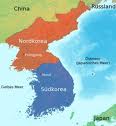Korea: North and South on Verge of War

The tensions on the Korean Peninsula have been escalating these days. A flow of tough rhetoric exchanges is unrelenting, Seoul and Pyongyang promise to wipe each other off from the face of the earth. The new phase of crisis was launched on March 8. North Korea pulled out of the 1953 armistice agreement and cut off the hot line with the United States and Seoul. For over half a century the unstable peace and balance of forces on the Peninsula had been based on this very legal infrastructure. Now North Korea has destroyed it.
Pyongyang is launching bellicose statements. It is saying the order is given to strike US military bases in different parts of the world, including the United States territory, North Korea considers itself to be in the state of war with South Korea etc. It’s hard to remain indifferent having heard such news.
At that! If we try to keep away from raging emotions and make a deep insight into the recent events, if we attentively study the cited North Korean documents, then we’ll see the following.
1) As before, the North Korea’s declarations make it clear the devastating strikes will be delivered only in response, in case the country is under attack. But there is ground to believe the words are a warning not to cross the “red line”.
Probably, North Korea has taken no irreversible decision to immediately start combat actions and attack first.
2) The game of balancing on the edge of a knife (so cold brinkmanship) presupposes there are many players and they all have roles and responsibilities. It’s like playing with fire. Washington and Seoul are blowing the fire with no less energy than Pyongyang.
North Korea is as hostile as it can be, but so far it’s only words. The other side is trying not to lag behind in exerting psychological pressure, but it is also taking practical steps that directly provoke further escalation of the stand-off.
The US has taken a decision to deploy additional interceptors in Alaska against the North Korean missiles, for the first time in many years US nuclear capable strategic bombers imitated nuclear strikes against North Korea during the recently held Key Resolve/Foal Eagle exercises – it’s not just rhetoric… It looks more like preparation for combat aimed at making the other side scared and demoralized.
Any state would find honing nuclear strikes skills at its border a highly provocative action and would respond resolutely.
It is important to realize the North Koreans have actually nowhere to retreat. Displaying any sign of weakness will have a devastating effect, there must be no doubt left it will fight to the end using all the means at its disposal in case an attack is launched.
At that, Washington and Seoul have recently announced they will hold one more exercise, the third during the last two months, which will last almost the whole April. It’s a Marine Corps exercise, so the scenario presupposes offensive actions. The location is a disputed sea border island territory in the Yellow Sea – the same waters where South Korea’s Yeonpyeong island shooting incident took place during military exercises in 2010. Nobody believes the words of organizers the exercises are of defensive nature.
The drills are held non-stop in the immediate vicinity of North Korean border in the most sensitive areas of disputed waters. It all gives rise to apprehensions that the US and South Korean plans are aimed at physical and psychological exhaustion of the North Korean armed forces and provoking them into starting a conflict.
The US and South Korea’s military “tailor” a legal base for joint combat actions. South Korean Army Gen. Jeong Sung-jo, the chairman of South Korea’s Joint Chiefs of Staff, and U.S. Army Gen. James D. Thurman, the commander of U.S.-Republic of Korea Combined Forces Command, announced March 24 that they had signed a combined plan to counter threats from North Korea (Plan to Counter North Korean Threats) stressing South Korea’s extended freedom of actions at the first stage of conflict.
No way, the escalation of hostile rhetoric on the part of North Korea could be justified. Still, the international community should send an unambiguous call addressed to all the sides divided by the 38 parallel calling for maximum restraint and measuring steps with possible implications, taking into consideration the other party’s reaction.
The explosive situation has exacerbated to the point when the Pueblo 1968 incident comes to mind. Back then the North Koreans boarded and captured the US naval research ship. Even being masters of conflict management, the United States may let the situation get out of control.
No doubt, the Russian diplomacy has launched efforts aimed at peaceful resolution of the stand-off.

